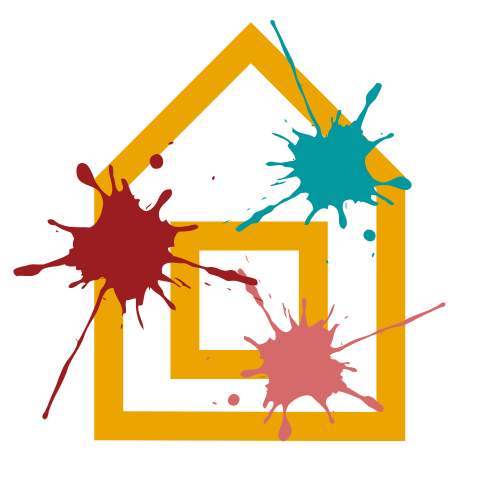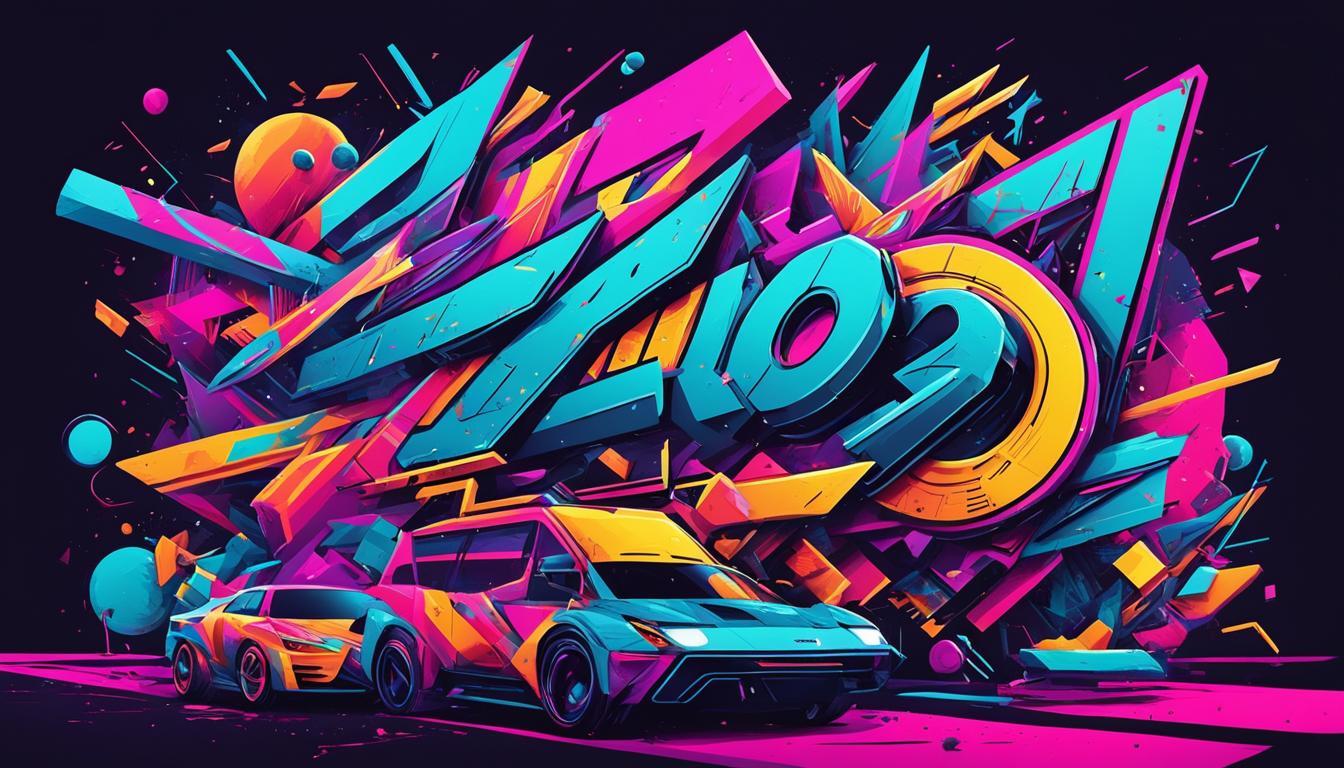Welcome to our journey into the rich and colorful realm of 90s art. In this article, we’ll delve into the diverse and dynamic landscape of nostalgic, vintage, retro, pop, contemporary, abstract, digital, urban, and graffiti art from the iconic 90s era. Join us as we uncover the lasting impact and vibrant creativity that defined this remarkable period.
But first, let’s set the stage with an image that encapsulates the essence of 90s art:
As you can see, this captivating artwork perfectly embodies the spirit and energy of the 90s, setting the tone for our exploration of this fascinating artistic era.
So, buckle up and prepare to be transported back in time as we dive into the influence of pop art, the nostalgia of vintage art, the revival of retro art, the brilliance of abstract art, the rise of digital art, and the raw expression of urban art and graffiti. Together, let’s uncover the lasting legacy and cultural significance of 90s art.
The Influence of Pop Art in the 90s
Pop art made a significant impact on the 90s art scene, shaping contemporary art in profound ways. Visionary artists such as Andy Warhol and Roy Lichtenstein pioneered a movement that celebrated vibrant colors, consumer culture, and mass media imagery.
As an artistic response to the consumer-driven society of the time, pop art challenged traditional artistic boundaries and embraced the aesthetics of popular culture. It thrived on the use of bold and vibrant colors, creating visually striking and iconic art pieces.
This movement resonated with a generation seeking to break free from conventional artistic norms and connect with the popular culture that surrounded them. The infusion of pop art into the 90s art scene brought a refreshing and contemporary approach to artistic expression.
The influence of pop art can still be seen in contemporary art today, with artists continuing to draw inspiration from its bold aesthetic and exploration of consumer culture. The 90s served as a pivotal moment for pop art, cementing its place as an important art movement that continues to captivate and inspire.
Key Takeaways:
- Pop art had a major influence on the 90s art scene.
- Andy Warhol and Roy Lichtenstein were prominent figures in the pop art movement.
- The use of vibrant colors and consumer culture became distinguishing features of 90s art.
- Pop art challenged traditional artistic boundaries and embraced popular culture.
- The influence of pop art can still be seen in contemporary art today.
Nostalgic and Vintage Art of the 90s
Nostalgia has always had a powerful effect on art, and the 90s were no exception. This era was rife with artists who drew inspiration from the iconic elements of the decade, creating nostalgic and vintage art that captured the essence of 90s fashion, music, and pop culture.
Through their art, these creators sought to evoke a sense of longing for the past, transporting us back to a time filled with beloved fashion trends, unforgettable music, and the cultural phenomena that defined the 90s. Whether it’s the grunge aesthetic, the vibrant colors, or the unforgettable icons, artworks from the 90s bring back a wave of nostalgia and sentimentality.
90s fashion, with its flannel shirts, ripped jeans, and platform shoes, is often immortalized in these artworks. The nostalgic art of the 90s embraces the unique aesthetics that defined the fashion era, reminding us of the bold statements and unconventional styles that were exalted during that time.
In addition to fashion, music played a vital role in 90s pop culture, and artists captured its spirit through their creations. From album art to illustrations of famous musicians, these artworks rekindle the memories and emotions associated with the music of the 90s. Listening to iconic bands like Nirvana, Spice Girls, and Backstreet Boys transports us back to a time when music was vibrant and diverse, making its mark on the cultural landscape.
It’s impossible to talk about 90s nostalgia without mentioning the cultural phenomena that defined the era. Artworks from the 90s paid homage to iconic films, TV shows, and memorable moments, tapping into our collective memory and reminding us of what made the 90s so special.
There’s something genuinely captivating about the nostalgia and vintage art of the 90s. It reignites our love for an era that was both unique and influential, while also allowing us to appreciate the creativity and innovation that emerged from that time.
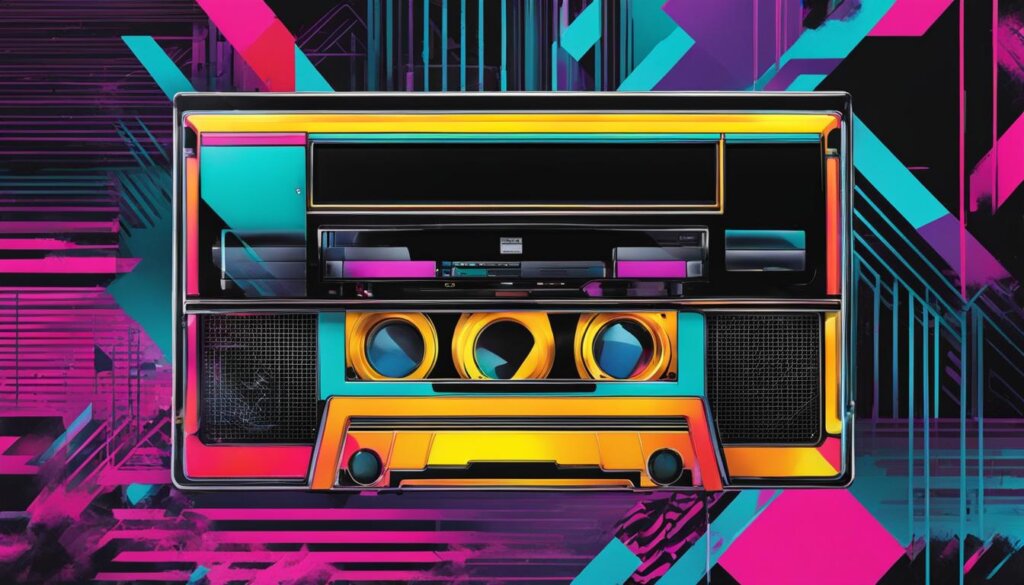
Join us in the next section as we explore the revival of retro art in the 90s, where artists embraced the bold and vibrant aesthetics of previous decades to create captivating and expressive artworks.
The Revival of Retro Art in the 90s
Retro art experienced a vibrant revival in the 90s, as artists enthusiastically embraced the bold and energetic aesthetics of previous decades. This artistic movement was characterized by its bold use of neon colors, geometric shapes, and stylized imagery, which created a distinct visual language synonymous with 90s design.
The resurgence of retro art in the 90s was more than just a nostalgic homage to the past; it served as a powerful fusion of nostalgia and contemporary sensibilities. The artists skillfully merged elements of the past with their own unique vision, creating artworks that embodied the spirit of the era and captivated audiences.
The vivid and eye-catching neon colors used in retro art during the 90s were a stark departure from the subdued color palettes of previous decades. These vibrant hues, inspired by the bright lights of the urban landscape, infused the artworks with a sense of energy and dynamism.
Geometric shapes played a central role in the aesthetic of retro art in the 90s. Artists expertly incorporated triangles, squares, circles, and other geometric forms to create visually striking compositions that emphasized boldness and symmetry. These geometrical elements added a sense of structure and balance to the artworks, further enhancing their appeal.
One of the iconic aspects of retro art in the 90s was the use of stylized imagery. Artists drew inspiration from various sources, including pop culture, advertising, and everyday objects, and transformed them into visually captivating artworks. The juxtaposition of familiar images in unconventional ways added an element of intrigue and playfulness to the retro art movement.
The revival of retro art in the 90s left a lasting impact on the art world. Its bold and vibrant aesthetics continue to influence contemporary artists, inspiring them to explore the boundaries of creativity and push the limits of artistic expression. Retro art in the 90s stands as a testament to the enduring power of blending nostalgia and modernity in art.
Visualize the dynamic retro art of the 90s with this image:
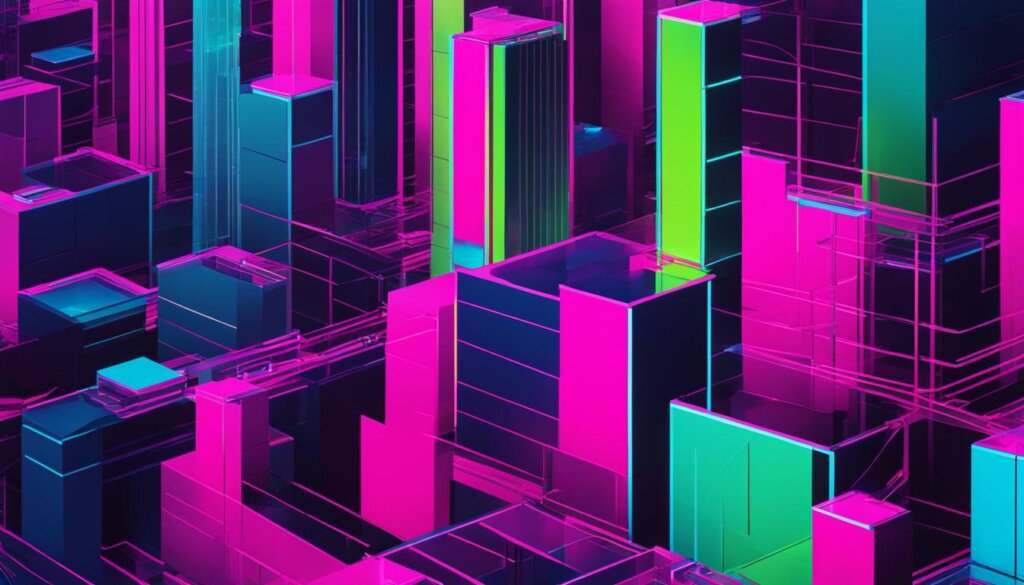
Exploring Abstract Art in the 90s
Abstract art was a pivotal movement in the 90s, pushing the boundaries of traditional artistic techniques and capturing the essence of the era in a non-representational form. Artists of the time embraced abstract art as a powerful medium to convey emotions and ideas through expressive brushstrokes, bold colors, and geometric abstraction.
In the 90s, abstract art emerged as a vibrant and dynamic force, challenging the conventional norms of representation. The artists of this era explored new forms of expression, unleashing their creativity by breaking away from the constraints of realistic depictions.
The expressive brushstrokes used in abstract art during this period not only added a sense of energy and movement to the canvases but also allowed artists to convey their innermost thoughts and feelings. These brushstrokes became a visual language of emotion, capturing the spirit of the time and reflecting the fast-paced nature of the evolving society.
Geometric abstraction also played a significant role in the development of abstract art in the 90s. Artists embraced clean lines and geometric shapes to create compositions that were harmonious and visually captivating. This approach allowed for a sense of order amidst the chaos, representing the desire for structure and balance in a rapidly changing world.
Contemporary artists in the 90s made significant contributions to the abstract art movement. Their innovative techniques and unique interpretations of abstract art helped shape the artistic landscape of the era. Artists like Mark Rothko, Cy Twombly, and Helen Frankenthaler brought their own distinct styles and perspectives, leaving a lasting impact on the art world.
Abstract art in the 90s remains a testament to the power of artistic expression. It captured the energy, spirit, and emotions of the era, serving as a visual representation of the societal changes and cultural shifts taking place. The abstract artworks of the 90s continue to inspire and influence contemporary artists, showcasing the enduring relevance and impact of this artistic movement.
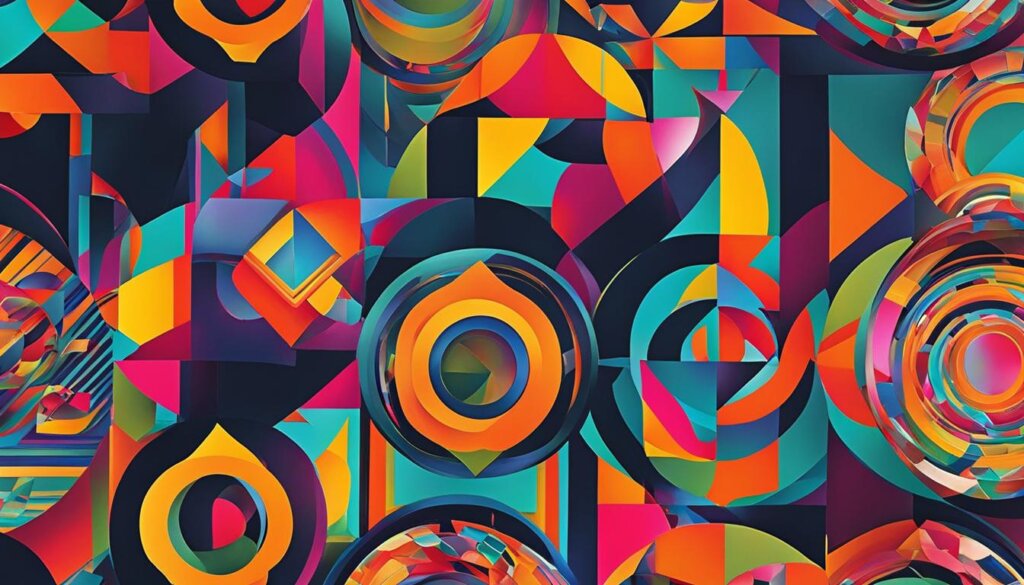
The Rise of Digital Art in the 90s
In the 1990s, the art world witnessed a significant shift with the rise of digital art. Technological advancements and the emergence of new media opened up endless possibilities for artists to explore and experiment. Digital tools became their creative arsenal, enabling them to push the boundaries of traditional artistic mediums.
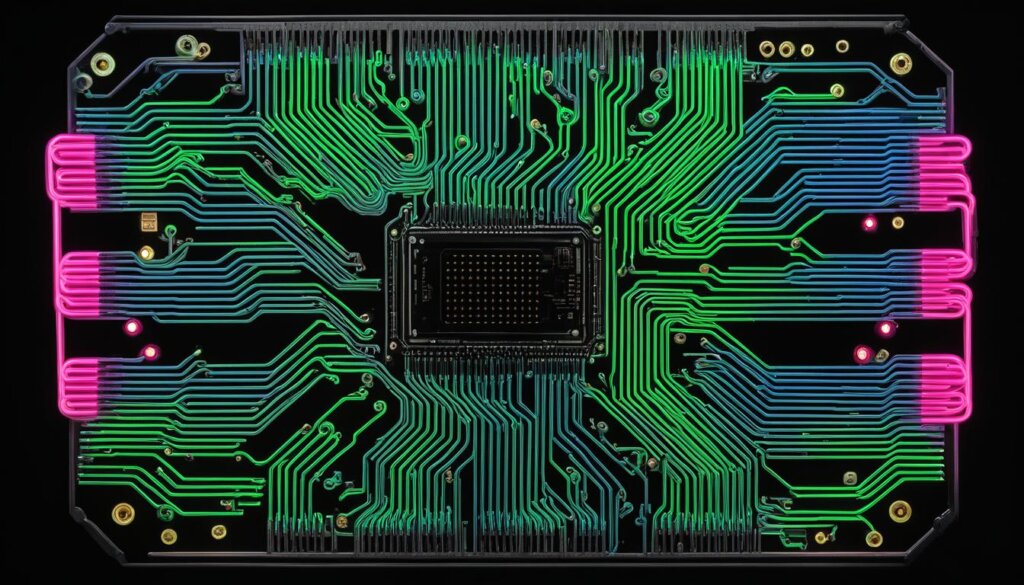
Digital art in the 90s was a fusion of technology and creativity, resulting in groundbreaking artworks that were influenced by the digital realm. Artists embraced the digital tools at their disposal, utilizing computer programs, graphic tablets, and other digital platforms to bring their visions to life.
The advent of digital art introduced a whole new dimension to artistic expression. It challenged the conventional notion of creating art solely with physical materials, opening up new avenues for creativity and innovation. Artists could now manipulate, morph, and experiment with images, colors, and forms in ways that were previously unimaginable.
The rise of digital art in the 90s paved the way for the exploration of new visual languages and techniques. Artists embraced the dynamics of the digital world, incorporating interactive elements and multimedia components into their works. The digital medium allowed for seamless integration of sound, video, and animation, creating immersive and multi-sensory experiences for viewers.
The Impact of Digital Art in the 90s
- Technological Advancements: Digital art in the 90s was made possible by the rapid advancements in technology at the time. The increasing availability of personal computers, graphic software, and digital imaging tools revolutionized the way artists approached their craft.
- Democratization of Art: The accessibility of digital tools brought art to a wider audience. Artists could now create, exhibit, and share their work online, transcending geographical and institutional boundaries. This democratization of art fostered a new era of artistic collaboration and community.
- New Forms of Expression: Digital art in the 90s allowed for experimentation and exploration beyond traditional artistic practices. Artists could manipulate digital imagery, create interactive installations, and explore virtual and augmented realities. This opened up endless possibilities for creative expression.
- Reimagining the Creative Process: With digital tools, artists could iterate, revise, and experiment in real-time. The flexibility and immediacy of the digital medium enabled artists to push their creative boundaries and challenge traditional artistic norms.
The rise of digital art in the 90s has had a lasting impact on the art world, with technological advancements continuing to shape artistic practices today. Digital art forms, such as generative art, virtual reality art, and algorithmic art, have become established genres within contemporary art. The 90s marked a pivotal moment in the evolution of art, as artists embraced new technologies, redefined artistic practices, and expanded the possibilities of creative expression.
Urban Art and Graffiti in the 90s
The 90s marked a significant turning point for urban art and graffiti, as artists took to the streets to express themselves in unconventional ways. Graffiti, once seen as an act of vandalism, evolved into a powerful form of subversive expression. Artists utilized vibrant colors, intricate designs, and thought-provoking messages to challenge societal norms and make their voices heard.
Urban art in the 90s became an integral part of street culture, capturing the essence of the era’s rebellious spirit. These artists found inspiration in the urban environment, transforming blank walls and abandoned spaces into canvases for artistic creation. With their bold and unapologetic approach, they left an indelible mark on the art world.
Through urban art and graffiti, the streets became a platform for self-expression, fostering communities of like-minded individuals. Artists banded together, creating collectives and collaborating on large-scale murals that reflected the diversity of street culture. The streets became a gallery, accessible to anyone willing to explore and engage with this unique art form.
The Power of Subversive Expression
Urban art and graffiti in the 90s allowed artists to address social and political issues that were often silenced or overlooked. By using public spaces as their canvas, artists made a visual statement that challenged the status quo. Through their work, they confronted topics such as inequality, racism, and consumerism, sparking conversations and provoking thought.
Subversive expression was at the core of urban art in the 90s. Artists defied conventional artistic norms and reclaimed public spaces, making art accessible to all. They carved out their own narrative in a world that tried to restrict their voices, using graffiti as a tool of empowerment and resistance.
Visual elements such as vibrant colors, bold lettering, and intricate designs became defining characteristics of graffiti art in the 90s. These visual cues, combined with powerful messages, allowed artists to create impactful pieces that demanded attention and sparked reflection.
Legacy and Influence
The impact of urban art and graffiti in the 90s can still be felt today. Many artists who emerged from that era continue to shape and redefine the art world. Their contributions have paved the way for the acceptance and recognition of urban art as a legitimate form of artistic expression.
Street culture, influenced by the subversive nature of graffiti, has permeated various aspects of contemporary art, from gallery exhibitions to multimedia installations. The vibrancy, energy, and rebellious spirit of 90s urban art have become ingrained in the cultural fabric of society.
Today, street art festivals, public art projects, and curated graffiti exhibitions celebrate the diversity and creativity of urban art. The 90s laid the groundwork for this cultural shift, pushing boundaries and challenging traditional notions of artistic expression.
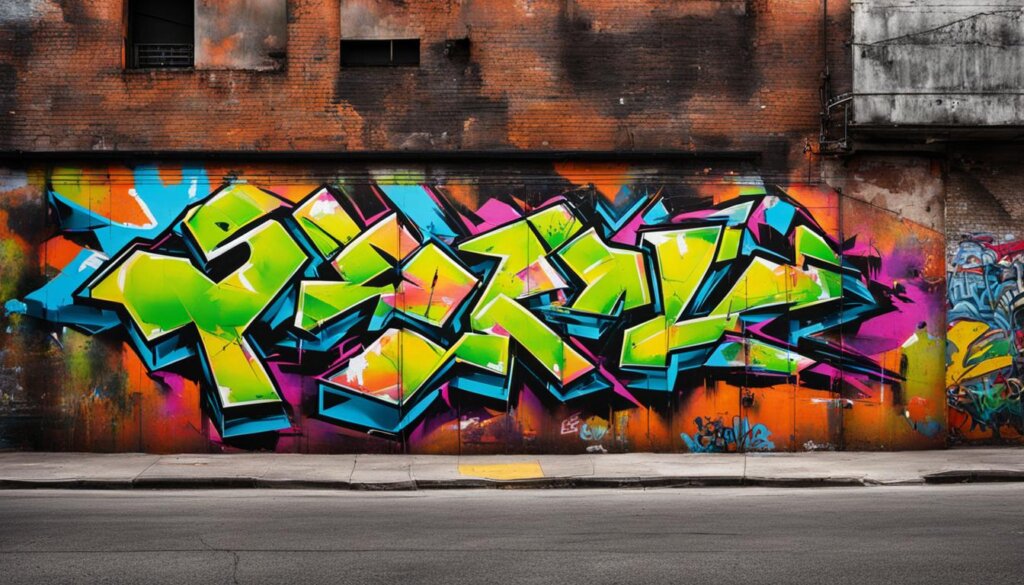
The Lasting Legacy of 90s Art
The artistic innovation and cultural influence of 90s art continue to shape the contemporary art world. From the bold experimentation to the vibrant aesthetics, the 90s introduced a diverse range of artistic styles that still inspire new generations of artists. The legacy of 90s art serves as a testament to the dynamic nature of artistic expression.
One of the key aspects of 90s art was its artistic innovation. Artists in this era pushed the boundaries of traditional techniques, exploring new mediums and approaches to create their works. From the expressive brushstrokes of abstract art to the use of digital tools in creating digital art, the 90s marked a period of exploration and experimentation that laid the foundation for contemporary art practices.
Moreover, the cultural influence of the 90s art scene cannot be understated. It was a time of immense cultural change, where art became a reflection of societal shifts. Urban art and graffiti emerged as powerful forms of subversive expression, challenging the established norms and bringing art to the streets. The impact of this street culture still resonates today, with urban art and graffiti continuing to shape contemporary art movements.
The legacy of 90s art extends beyond its own time, as its influence can be seen in current art trends. The vibrant aesthetics and eclectic mix of artistic styles that emerged in the 90s have shaped the direction of contemporary art. Artists today draw inspiration from the bold colors, vivid imagery, and diverse forms of artistic expression that characterized the 90s art scene. The lasting legacy of 90s art serves as a constant reminder of the power of artistic innovation and the ability of art to captivate and inspire.
